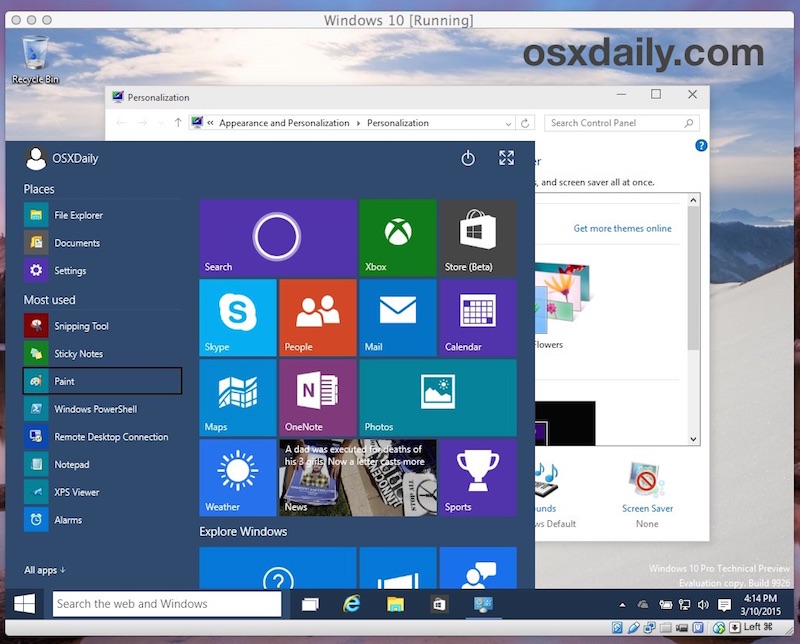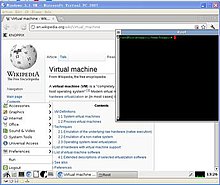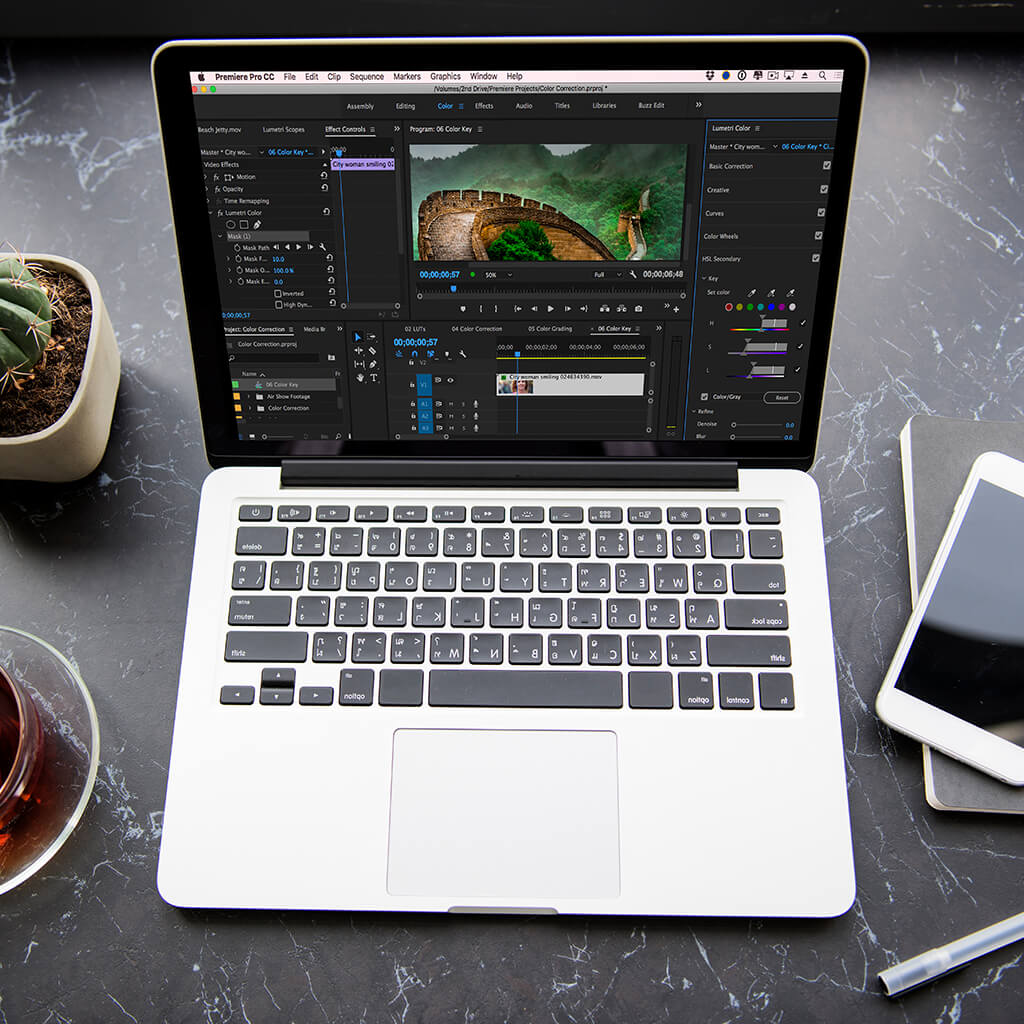- Microsoft Virtual Pc For Mac Os X 10.12
- Virtual Mac Online
- Microsoft Virtual Pc Mac Os X
- Mac Os X Virtual Machine
- Microsoft Virtual Pc For Mac Os X64
Microsoft Virtual PC 7.0 is a software application for Mac's, designed to allow windows based programs to run on your mac without the hassel of having to partition a drive, Install a completey new OS or set up a VM or 'Virtual Machine,' to do so, just install and go. Download Microsoft Virtual PC 7.0 for Mac. The biggest issue preventing the running of Mac OS X in a virtual machine on a Windows computer is Licensing This describes an environment into which you can install and run Windows 7 and compatible applications. VMware Fusion: Powerfully Simple Virtual Machines for Mac VMware Fusion Pro and VMware Fusion Player Desktop Hypervisors give Mac users the power to run Windows on Mac along with hundreds of other operating systems, containers or Kubernetes clusters. Microsoft Query X for Mac 10.0 is a tool utilizing Open Database Connectivity (ODBC) for importing data from databases into Microsoft Excel X. You can use Query X to create new queries or refresh existing queries that were created in. Office 2004 for Mac is a version of Microsoft Office developed for Mac OS X.It is equivalent to Office 2003 for Windows. The software was originally written for PowerPC Macs, so Macs with Intel CPUs must run the program under Mac OS X's Rosetta emulation layer. For this reason, it is not compatible with Mac OS X 10.7 and newer. Office 2004 was replaced by its successor, Microsoft Office 2008.
Screenshot of Microsoft Word 2004 on an Intel-based Mac in Mac OS X v10.4 'Tiger' through Rosetta | |
| Developer(s) | Microsoft |
|---|---|
| Initial release | May 11, 2004; 16 years ago |
| Stable release | |
| License | |
| Website | microsoft.com/mac/products |
| System requirements | |
|---|---|
| CPU | PowerPC G3 or higher |
| Operating system | Mac OS X v10.2.8 through v10.6.8 |
| RAM | 256 MB |
| Free hard disk space | 450 MB |
Office 2004 for Mac is a version of Microsoft Office developed for Mac OS X. It is equivalent to Office 2003 for Windows. The software was originally written for PowerPC Macs, so Macs with Intel CPUs must run the program under Mac OS X's Rosetta emulation layer. For this reason, it is not compatible with Mac OS X 10.7 and newer.
Office 2004 was replaced by its successor, Microsoft Office 2008 for Mac, which was developed as a universal binary to run natively on Intel Macs. However, Office 2008 did not include support for Visual Basic for Applications, which made Microsoft extend the support period of Office 2004 from October 13, 2009 to January 10, 2012.[3] Microsoft ultimately shipped support for Visual Basic in Microsoft Office 2011 for Mac, which also dropped PowerPC support altogether. Support for Office 2004 ended January 10, 2012.[2]
Editions[edit]
Microsoft Office for Mac 2004 is available in three editions: Standard, Professional, and Student and Teacher. All three editions include Word, Excel, PowerPoint and Entourage. The Professional Edition adds Virtual PC. The Student and Teacher Edition cannot be upgraded, which means when a later version of Office is released, people who purchased the Student and Teacher edition must buy a new package.
Features[edit]
Word 2004[edit]
Microsoft Word is a word processor which possesses a dominant market share in the word processor market. Its proprietary DOC format is considered a de facto standard, although its successive Windows version (Word 2007) uses a new XML-based format called .DOCX, but has the capability of saving and opening the old .DOC format.
CCleaner for Mac! Clean up your Mac and keep your browsing behaviour private with CCleaner, the world's favourite computer cleaning tool. Skip to main content. How to clear memory on mac. Clearing the System Cache: Close as many open programs as possible. Open programs use files.
The new Office Open XML format was built into the next version of Office for Mac (Office 2008). However, it is also supported on Office 2004 with the help of a free conversion tool available from Microsoft.[4]
Excel 2004[edit]
Microsoft Excel is a spreadsheet program. Like Microsoft Word, it possesses a dominant market share. It was originally a competitor to the dominant Lotus 1-2-3, but it eventually outsold it and became the de facto standard for spreadsheet programs.
Entourage 2004[edit]
Microsoft Entourage is an email application. Its personal information management features include a calendar, address book, task list, note list, and project manager. With Entourage 2004, Microsoft began offering a Project Center, which allows the user to create and organize projects. Information may come from within Entourage or outside the program.
PowerPoint 2004[edit]
Microsoft PowerPoint is a popular presentation program used to create slideshows composed of text, graphics, movies and other objects, which can be displayed on-screen and navigated through by the presenter or printed out on transparencies or slides. It too possesses a dominant market share. Movies, videos, sounds and music, as well as wordart and autoshapes can be added to slideshows.
Microsoft Virtual Pc For Mac Os X 10.12
Virtual PC[edit]
Included with Office 2004 for Mac Professional Edition, Microsoft Virtual PC is a hypervisor which emulates Microsoft Windowsoperating systems on Mac OS X which are PowerPC-based. Virtual PC does not work on Intel-based Macs and in August 2006, Microsoft announced it would not be ported to Intel-based Macintoshes, effectively discontinuing the product as PowerPC-based Macintoshes are no longer manufactured.
Criticism[edit]
Images inserted into any Office 2004 application by using either cut and paste or drag and drop result in a file that does not display the inserted graphic when viewed on a Windows machine. Instead, the Windows user is told 'QuickTime and a TIFF (LZW) decompressor are needed to see this picture'. Peter Clark of Geek Boy's Blog presented one solution in December 2004.[5] However, this issue persists in Office 2008.
There is no support for editing right to left and bidirectional languages (such as Arabic, Hebrew, Persian, etc.) in Office 2004. This issue has not been fixed in Office 2008 or 2011 either.[6][7]
See also[edit]
References[edit]
- ^'Download Microsoft Office 2004 for Mac 11.6.6 Update'. Download Center. Microsoft. December 13, 2011. Archived from the original on July 5, 2012.
- ^ ab'Microsoft Support Lifecycle'. Support. Microsoft. Retrieved April 28, 2013.
- ^Tedesco, Mike (October 12, 2009). 'Office 2004 Mainstream Support Has Been Extended'. Mactopia. Microsoft. Archived from the original on October 17, 2009. Retrieved October 12, 2009.
- ^'MS11-072: Description of the Open XML File Format Converter for Mac 1.2.1: September 13, 2011'. Support. Microsoft. September 13, 2011.
- ^Clark, Peter (December 6, 2004). 'QuickTime and a TIFF (LZW) decompressor are needed to see this picture'. Geek Boy's Blog. Archived from the original on May 10, 2013. Retrieved October 12, 2009.Alt URL
- ^Heard, Chris (September 27, 2007). 'It's official: no RTL support in Microsoft Office 2008 for Mac'. Higgaion. Archived from the original on October 11, 2007. Retrieved October 12, 2009.
- ^Morgenstern, David (August 8, 2010). 'Microsoft boosts languages, proofing tools in Office 2011 for Mac, Unicode right-to-left support missing'. ZDNet. CBS Interactive. Retrieved April 27, 2013.
What you need to install Windows 10 on Mac
- MacBook introduced in 2015 or later
- MacBook Air introduced in 2012 or later
- MacBook Pro introduced in 2012 or later
- Mac mini introduced in 2012 or later
- iMac introduced in 2012 or later1
- iMac Pro (all models)
- Mac Pro introduced in 2013 or later

The latest macOS updates, which can include updates to Boot Camp Assistant. You will use Boot Camp Assistant to install Windows 10.

64GB or more free storage space on your Mac startup disk:
- Your Mac can have as little as 64GB of free storage space, but at least 128GB of free storage space provides the best experience. Automatic Windows updates require that much space or more.
- If you have an iMac Pro or Mac Pro with 128GB of memory (RAM) or more, your startup disk needs at least as much free storage space as your Mac has memory.2
An external USB flash drive with a storage capacity of 16GB or more, unless you're using a Mac that doesn't need a flash drive to install Windows.
A 64-bit version of Windows 10 Home or Windows 10 Pro on a disk image (ISO) or other installation media. If installing Windows on your Mac for the first time, this must be a full version of Windows, not an upgrade. Wd my passport ultra 1tb for mac.
- If your copy of Windows came on a USB flash drive, or you have a Windows product key and no installation disc, download a Windows 10 disk image from Microsoft.
- If your copy of Windows came on a DVD, you might need to create a disk image of that DVD.
Virtual Mac Online
How to install Windows 10 on Mac
To install Windows, use Boot Camp Assistant, which is included with your Mac.


1. Use Boot Camp Assistant to create a Windows partition
Open Boot Camp Assistant, which is in the Utilities folder of your Applications folder. Then follow the onscreen instructions.
- If you're asked to insert a USB drive, plug your USB flash drive into your Mac. Boot Camp Assistant will use it to create a bootable USB drive for Windows installation.
- When Boot Camp Assistant asks you to set the size of the Windows partition, remember the minimum storage-space requirements in the previous section. Set a partition size that meets your needs, because you can't change its size later.
2. Format the Windows (BOOTCAMP) partition
When Boot Camp Assistant finishes, your Mac restarts to the Windows installer. If the installer asks where to install Windows, select the BOOTCAMP partition and click Format. In most cases, the installer selects and formats the BOOTCAMP partition automatically.
3. Install Windows
Microsoft Virtual Pc Mac Os X
Unplug any external devices that aren't necessary during installation. Then click Next and follow the onscreen instructions to begin installing Windows.
4. Use the Boot Camp installer in Windows
After Windows installation completes, your Mac starts up in Windows and opens a ”Welcome to the Boot Camp installer” window. Follow the onscreen instructions to install Boot Camp and Windows support software (drivers). You will be asked to restart when done.
- If the Boot Camp installer never opens, open the Boot Camp installer manually and use it to complete Boot Camp installation.
- If you have an external display connected to a Thunderbolt 3 port on your Mac, the display will be blank (black, gray, or blue) for up to 2 minutes during installation.
How to switch between Windows and macOS
Restart, then press and hold the Option (or Alt) ⌥ key during startup to switch between Windows and macOS.
Learn more
Mac Os X Virtual Machine
If you have one of these Mac models using OS X El Capitan 10.11 or later, you don't need a USB flash drive to install Windows:
- MacBook introduced in 2015 or later
- MacBook Air introduced in 2017 or later3
- MacBook Pro introduced in 2015 or later3
- iMac introduced in 2015 or later
- iMac Pro (all models)
- Mac Pro introduced in late 2013
To remove Windows from your Mac, use Boot Camp Assistant, not any other utility.
For more information about using Windows on your Mac, open Boot Camp Assistant and click the Open Boot Camp Help button.
1. If you're using an iMac (Retina 5K, 27-inch, Late 2014) or iMac (27-inch, Late 2013) or iMac (27-inch, Late 2012) with a 3TB hard drive and macOS Mojave or later, learn about an alert you might see during installation.
Microsoft Virtual Pc For Mac Os X64
2. For example, if your Mac has 128GB of memory, its startup disk must have at least 128GB of storage space available for Windows. To see how much memory your Mac has, choose Apple menu > About This Mac. To see how much storage space is available, click the Storage tab in the same window.
3. These Mac models were offered with 128GB hard drives as an option. Apple recommends 256GB or larger hard drives so that you can create a Boot Camp partition of at least 128GB.

